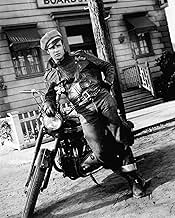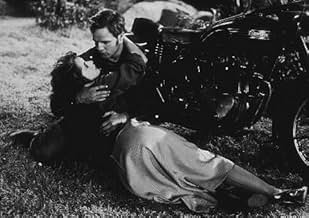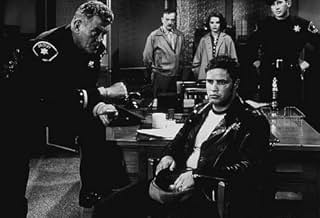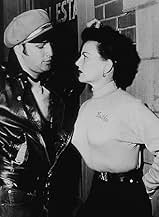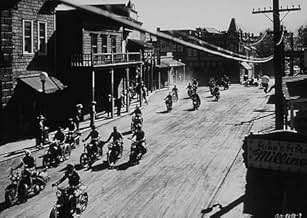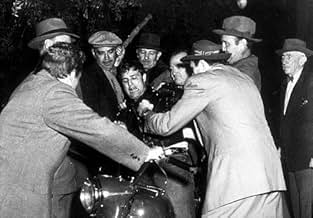NOTE IMDb
6,7/10
19 k
MA NOTE
Deux gangs de motards rivaux terrorisent une petite ville après qu'un de leurs chefs est jeté en prison.Deux gangs de motards rivaux terrorisent une petite ville après qu'un de leurs chefs est jeté en prison.Deux gangs de motards rivaux terrorisent une petite ville après qu'un de leurs chefs est jeté en prison.
- Réalisation
- Scénario
- Casting principal
Wally Albright
- Cyclist
- (non crédité)
Chris Alcaide
- Deputy
- (non crédité)
Don Anderson
- Stinger
- (non crédité)
Robert Anderson
- Highway Patrolman at Sage Valley Race
- (non crédité)
Robert Bice
- Wilson
- (non crédité)
Avis à la une
Would this movie still be watched but for Brando's performance? I think not - it would be relegated to the scrap heap of old B movies. But Brando carries the movie by having the right qualities to play Johnny Strabler, the leader of a motorcycle gang that creates havoc in a small California town. Brando plays Johhny with sullen, smoldering rebelliousness with a suggestion of depth and vulnerability underneath. Brando had already shown his abilities in "A Streetcar Named Desire" and was soon to make "On the Waterfront." The performance here is not up to those standards, but it is engaging. At the time he made this movie Brando's star power was such that he could name his roles, so it is interesting to speculate why he chose to make this. Maybe this role appealed to his own rebellious spirit.
The movie is dated for sure, but you may learn some things about the 1950s that you won't find in the history books. Many early 50s anachronisms are in evidence: 78 records on the jukebox, references to television as being new, bebop music and argot, local HUMAN telephone operators. The comment the old bartender makes about the advent of TV is prescient, "Everything is noise and pictures, nobody talks to anyone anymore" - there is more truth to that with each passing decade. The score - generic, loud, obvious, and intrusive - would not be accepted in contemporary movies. Johnny's attempt to be cool by snapping his fingers to music on the jukebox is so phony as to be embarrassing. One interesting thing was to see an early version of the high-five in response to the interjection "pop me." But credit must be given for this being one of the first mainstream movies to treat the rebellion against the claustrophobic conformity and cold war angst of the early 50s. It was unique for its time.
We do not get much motivation for the reasons the gang members behave the way they do. There are mighty few specifics about the guys in the gang - where they come from, how they support themselves, or what they do besides terrorize small towns. We get only a hint of Johnny's past when, during a beating by the locals he says, "My old man used to hit harder than that." But, maybe all we need to know comes from Johnny's extolling the feeling he gets when getting on his cycle to "just go."
There are many memorable scenes, like the one where Johnny is asked if he doesn't want to thank some people who have done him a good deed and he comes to an inarticulate stop only to have his woman friend say, "That's okay, he doesn't know how."
Lee Marvin has a good go playing Chino, the head of a rival gang that had split off from Johnny's. Chino is the more stereotypical bad ass. He may not have the complex personality of Johnny, but Marvin seems to be having such a grand time in playing him that it is hard not to share in the fun.
There is some interesting photography such as the opening scene where the cyclists roar right over the camera placed in the center of the road. And there is some good night-time black and white work as well.
In an era of drive-by shootings, heavy drug trafficking, and internet pornography the events in this movie can seem pretty tame, but one should not underestimate the number of themes addressed - ones that are still relevant: standing up to intimidation, vigilantism, the desire for freedom, misinterpretation of behavior (with unfortunate consequences), the proper use of force, sex, crowd behavior, generational conflicts and confusions, the ills of stereotyping, and greed.
Also, one lesson to be learned is that steatopygous actors should not wear tight jeans.
The movie is dated for sure, but you may learn some things about the 1950s that you won't find in the history books. Many early 50s anachronisms are in evidence: 78 records on the jukebox, references to television as being new, bebop music and argot, local HUMAN telephone operators. The comment the old bartender makes about the advent of TV is prescient, "Everything is noise and pictures, nobody talks to anyone anymore" - there is more truth to that with each passing decade. The score - generic, loud, obvious, and intrusive - would not be accepted in contemporary movies. Johnny's attempt to be cool by snapping his fingers to music on the jukebox is so phony as to be embarrassing. One interesting thing was to see an early version of the high-five in response to the interjection "pop me." But credit must be given for this being one of the first mainstream movies to treat the rebellion against the claustrophobic conformity and cold war angst of the early 50s. It was unique for its time.
We do not get much motivation for the reasons the gang members behave the way they do. There are mighty few specifics about the guys in the gang - where they come from, how they support themselves, or what they do besides terrorize small towns. We get only a hint of Johnny's past when, during a beating by the locals he says, "My old man used to hit harder than that." But, maybe all we need to know comes from Johnny's extolling the feeling he gets when getting on his cycle to "just go."
There are many memorable scenes, like the one where Johnny is asked if he doesn't want to thank some people who have done him a good deed and he comes to an inarticulate stop only to have his woman friend say, "That's okay, he doesn't know how."
Lee Marvin has a good go playing Chino, the head of a rival gang that had split off from Johnny's. Chino is the more stereotypical bad ass. He may not have the complex personality of Johnny, but Marvin seems to be having such a grand time in playing him that it is hard not to share in the fun.
There is some interesting photography such as the opening scene where the cyclists roar right over the camera placed in the center of the road. And there is some good night-time black and white work as well.
In an era of drive-by shootings, heavy drug trafficking, and internet pornography the events in this movie can seem pretty tame, but one should not underestimate the number of themes addressed - ones that are still relevant: standing up to intimidation, vigilantism, the desire for freedom, misinterpretation of behavior (with unfortunate consequences), the proper use of force, sex, crowd behavior, generational conflicts and confusions, the ills of stereotyping, and greed.
Also, one lesson to be learned is that steatopygous actors should not wear tight jeans.
From what I understand this movie was one of the first films about biker gangs and due to its well-deserved reception resulted in a number of similar movies since then. Essentially, "Johnny Strabler" (played by Marlon Brando) is the leader of a motorcycle club known as the Black Rebels which just happens to ride into the small California town of Wrightsville. Upon entering the local café he spies a young waitress by the name of "Kathie Bleeker" (Mary Murphy) and decides to get to know her a little better. Not long afterward another motorcycle gang called the Beetles also arrives and their leader, named "Chino" (Lee Marvin), decides to provoke Johnny into a fight in the middle of the street. One thing leads to another and Chino is eventually arrested which causes both motorcycle clubs to spend the night in Wrightsville. That's when all hell breaks loose. Now rather than reveal any more of this movie and risk spoiling it for those who haven't seen it I will just say that although this film is rather dated it still manages to entertain fairly well. I especially liked the performances of both Marlon Brando and Mary Murphy who both played their parts quite well. In any case, I recommend this movie to all of those who might enjoy a film of this nature and rate it as above average.
A peaceable town is taken over by motorcycle rowdies.
Despite the sometimes frat boy antics of gang members, the movie came across to audiences of the time as something of a 50's nightmare. For example, there's a small town taken over by motorcycle outlaws, a virginal girl (Murphy) surrounded by rowdies, a cop too meek to intervene, and a general breakdown of peace, quiet and conformity. In short, it's a challenge to the every day norms the famously inarticulate Johnny (Brando) is rebelling against. It's that sort of restlessness that takes the gang to the highway, and the excitement they seek. But it's also a nation recovering from the rigors of a big Depression and the disruptions of WWII. So the two are bound to clash. The movie may seem tame by today's graphic standards, but for the 1950's it was a barbarian assault against the decade's defining conventions. No wonder, the film was condemned in so many places.
Truth be told, Brando doesn't act so much as he poses. Nonetheless, it's an iconic pose in cap and sunglasses that shot him to the forefront of the decade's celebrated rebels. For example, catch how delicately he positions the sunglasses or how he slouches silently by while others cavort. Still, the movie really comes alive when Lee Marvin (Chino) and his gang hit town. He's the loudmouth opposite of Johnny, looking to knock him off his regal pose, which he tries in a well-staged fistfight. Then there's Mary Murphy's good girl, a perfect casting choice. When she flees down a darkened street just ahead of the motorcycle rowdies, I could feel frozen shudders all over the theater of that day. It was like small town America about to be ravaged. Of course, the tables are turned when some of the town's bolder elements form into vigilantes and chase Johnny down the same street. I guess violence, as they say, really is a two-way street.
Anyway, the movie's still a milestone worth catching up with. My only gripe is with the cheapness of the production. The town and the sets are bare bones, especially in the movie's latter half. Maybe that was intentional in order to highlight the story. But if so, it came at the expense of a realistic undercurrent, especially the atrocious exterior set for Johnny and Kathie's little get-away, appearing more like a stage play than a film. All in all, it's a signature movie for the young Brando, cementing his rebel image for a generation.
Despite the sometimes frat boy antics of gang members, the movie came across to audiences of the time as something of a 50's nightmare. For example, there's a small town taken over by motorcycle outlaws, a virginal girl (Murphy) surrounded by rowdies, a cop too meek to intervene, and a general breakdown of peace, quiet and conformity. In short, it's a challenge to the every day norms the famously inarticulate Johnny (Brando) is rebelling against. It's that sort of restlessness that takes the gang to the highway, and the excitement they seek. But it's also a nation recovering from the rigors of a big Depression and the disruptions of WWII. So the two are bound to clash. The movie may seem tame by today's graphic standards, but for the 1950's it was a barbarian assault against the decade's defining conventions. No wonder, the film was condemned in so many places.
Truth be told, Brando doesn't act so much as he poses. Nonetheless, it's an iconic pose in cap and sunglasses that shot him to the forefront of the decade's celebrated rebels. For example, catch how delicately he positions the sunglasses or how he slouches silently by while others cavort. Still, the movie really comes alive when Lee Marvin (Chino) and his gang hit town. He's the loudmouth opposite of Johnny, looking to knock him off his regal pose, which he tries in a well-staged fistfight. Then there's Mary Murphy's good girl, a perfect casting choice. When she flees down a darkened street just ahead of the motorcycle rowdies, I could feel frozen shudders all over the theater of that day. It was like small town America about to be ravaged. Of course, the tables are turned when some of the town's bolder elements form into vigilantes and chase Johnny down the same street. I guess violence, as they say, really is a two-way street.
Anyway, the movie's still a milestone worth catching up with. My only gripe is with the cheapness of the production. The town and the sets are bare bones, especially in the movie's latter half. Maybe that was intentional in order to highlight the story. But if so, it came at the expense of a realistic undercurrent, especially the atrocious exterior set for Johnny and Kathie's little get-away, appearing more like a stage play than a film. All in all, it's a signature movie for the young Brando, cementing his rebel image for a generation.
"Hey Johnny, what are you rebelling against ? -Whadaaya got ?"
This simple exchange sums up the spirit, or lack of , that inhabits the tumultuous heart of Johnny Stabler, the leader of the Black Rebel Motorcycle Club bikers riding like formerly the horsemen of the Apocalypse their Triumphs, or their triumph over a square alienating norm whose only trophy is defiance and suspicion. People see them as hoodlums, they define themselves as rebels but Johnny gives the perfect answer to the inevitable question. What have you got?
Indeed, there's nothing that doesn't invite to rebellion, it's not just being against the norm or the system but not even making a norm out of one's rebellion, the idea is simply to go, to escape from the conditioning and alienating effect of civilization. These guys aren't the baby boomers, they lived the War, they remember its effect on the elder, they inherited an America to rebuild, but the spirit was all lost in the greatest generation's souls. They're part of the rebirth of America and its conquering spirit, but only in the name of motorbikes, bottle of beers and rock'n'roll.
"The Wild One" directed by Laslo Benedek is the first of a trilogy that can be defined as the "Rebellious Youth of the 50's" followed by "Blackboard Jungle" and the the iconic "Rebel Without a Cause" (a title that could have fitted this one). James Dean's movie dealt with rebellion from an Oedipal point of view, showing the roots of the youth's unease, the absence of a true model to respect. "Blackboard Jungle" was more about the failure of education. But "The Wild One" shows the results without getting through their background, all we see is these kids in their 20's looking for vast landscapes for driving, bars where partying, and towns for terrorizing.
And the first two films have one thing in common, they start with the infamous headliners, you know these big words that don't take the viewer's intelligence for granted. Yes, we know the whole rhapsody; this lost youth is revealing of the failure of a system and let us pray for it will never happen again. Did we need that? I guess it's like the famous Cagney-Robinson movies in the 30's were people weren't used to see gangster playing the lead roles. Well, the 50's had to deal with rebellious minds, no less dangerous, except for the fact that they didn't cause trouble for money, they had no reason whatsoever to act like they did, they did because well, why not?
And the casting of Marlon Brando as the seminal rebellious kid is the film's masterstroke not just because of his iconic look, 2 years before James Dean with the leather jacket, the hat, and the Triumph, one of the most defining images of the 50's, there's more to that, there's Marlon Brando, there's this constant enigma engraved in his face. This is something I sensed in most of the characters he played in the 50's, we never exactly know what he thinks, what he feels, and most of the time, his character gets away with his secret. Johnny Stabler is no exception, he doesn't emerge from the group as a leader but as a natural outcast with one hell of an aura.
This is pure Brandonian detachment, and I love it. See how he subtly escapes from the gang as soon as he sees the beautiful Kathie (Mary Murphy), yes, it's obligatory romantic subplot but Brando elevates it to another dimension ever improving HER acting by the miracle of his presence. I suspect the moment she tried to get the capsule of his bottle and he took it away from her, was one of these improvisations he has the secrets. Brando plays everything, he's tough, sensitive, intriguing and fascinating. Ultimately, she despises his gang, but in no way, she can despise him because there is something incredibly attractive in that guy who doesn't enjoy attracting.
This is the rebellious attitude, a nihilistic escape in the world and within oneself, without coming back with no one on one's back. Stabler has no connection with the past, he never looks back, if he takes the girl, she's got to go with him, if he doesn't trust the cop, it's because he did before and it cost him a lot. Always moving forward . Is his motto, although when one of his gang friends is injured by an old man, observing the cute Kathie, he decides to stay. The townspeople try to accommodate with the gang but it's only a matter of time, and beer that the generation gap shows its limits, forcing the local councilman, Mary's meek father, to interfere. But the man is incapable to use his weapon, abandoning all the control to the angry mob lead by a local bully.
"The Wild One" isn't the subtlest script ever but I admire its straight-forward way to make its point in 80 minutes that feel longer, this is how thrilling it is. There is a bit of wilderness and soft-headedness in all of us, it's all about which button to press. Its primitive, simplistic, but for some reason it works and Brando is mainly the cause, but I wouldn't attribute all the merit to him, there is a stellar performance, from, Lee Marvin as his rival Chino, almost stealing the legend's show and an unrecognizably young Tim Carey as one of the hoodlums.
As simple as the film is, it'll be forever renowned for its iconic image of Brando and his indelible quote, enough to put it in the legendary 50's, a must-see definitely, a cult-classic or the Easy Rider of the 50's And Marlon Brando was born to be (the) Wild (one).
This simple exchange sums up the spirit, or lack of , that inhabits the tumultuous heart of Johnny Stabler, the leader of the Black Rebel Motorcycle Club bikers riding like formerly the horsemen of the Apocalypse their Triumphs, or their triumph over a square alienating norm whose only trophy is defiance and suspicion. People see them as hoodlums, they define themselves as rebels but Johnny gives the perfect answer to the inevitable question. What have you got?
Indeed, there's nothing that doesn't invite to rebellion, it's not just being against the norm or the system but not even making a norm out of one's rebellion, the idea is simply to go, to escape from the conditioning and alienating effect of civilization. These guys aren't the baby boomers, they lived the War, they remember its effect on the elder, they inherited an America to rebuild, but the spirit was all lost in the greatest generation's souls. They're part of the rebirth of America and its conquering spirit, but only in the name of motorbikes, bottle of beers and rock'n'roll.
"The Wild One" directed by Laslo Benedek is the first of a trilogy that can be defined as the "Rebellious Youth of the 50's" followed by "Blackboard Jungle" and the the iconic "Rebel Without a Cause" (a title that could have fitted this one). James Dean's movie dealt with rebellion from an Oedipal point of view, showing the roots of the youth's unease, the absence of a true model to respect. "Blackboard Jungle" was more about the failure of education. But "The Wild One" shows the results without getting through their background, all we see is these kids in their 20's looking for vast landscapes for driving, bars where partying, and towns for terrorizing.
And the first two films have one thing in common, they start with the infamous headliners, you know these big words that don't take the viewer's intelligence for granted. Yes, we know the whole rhapsody; this lost youth is revealing of the failure of a system and let us pray for it will never happen again. Did we need that? I guess it's like the famous Cagney-Robinson movies in the 30's were people weren't used to see gangster playing the lead roles. Well, the 50's had to deal with rebellious minds, no less dangerous, except for the fact that they didn't cause trouble for money, they had no reason whatsoever to act like they did, they did because well, why not?
And the casting of Marlon Brando as the seminal rebellious kid is the film's masterstroke not just because of his iconic look, 2 years before James Dean with the leather jacket, the hat, and the Triumph, one of the most defining images of the 50's, there's more to that, there's Marlon Brando, there's this constant enigma engraved in his face. This is something I sensed in most of the characters he played in the 50's, we never exactly know what he thinks, what he feels, and most of the time, his character gets away with his secret. Johnny Stabler is no exception, he doesn't emerge from the group as a leader but as a natural outcast with one hell of an aura.
This is pure Brandonian detachment, and I love it. See how he subtly escapes from the gang as soon as he sees the beautiful Kathie (Mary Murphy), yes, it's obligatory romantic subplot but Brando elevates it to another dimension ever improving HER acting by the miracle of his presence. I suspect the moment she tried to get the capsule of his bottle and he took it away from her, was one of these improvisations he has the secrets. Brando plays everything, he's tough, sensitive, intriguing and fascinating. Ultimately, she despises his gang, but in no way, she can despise him because there is something incredibly attractive in that guy who doesn't enjoy attracting.
This is the rebellious attitude, a nihilistic escape in the world and within oneself, without coming back with no one on one's back. Stabler has no connection with the past, he never looks back, if he takes the girl, she's got to go with him, if he doesn't trust the cop, it's because he did before and it cost him a lot. Always moving forward . Is his motto, although when one of his gang friends is injured by an old man, observing the cute Kathie, he decides to stay. The townspeople try to accommodate with the gang but it's only a matter of time, and beer that the generation gap shows its limits, forcing the local councilman, Mary's meek father, to interfere. But the man is incapable to use his weapon, abandoning all the control to the angry mob lead by a local bully.
"The Wild One" isn't the subtlest script ever but I admire its straight-forward way to make its point in 80 minutes that feel longer, this is how thrilling it is. There is a bit of wilderness and soft-headedness in all of us, it's all about which button to press. Its primitive, simplistic, but for some reason it works and Brando is mainly the cause, but I wouldn't attribute all the merit to him, there is a stellar performance, from, Lee Marvin as his rival Chino, almost stealing the legend's show and an unrecognizably young Tim Carey as one of the hoodlums.
As simple as the film is, it'll be forever renowned for its iconic image of Brando and his indelible quote, enough to put it in the legendary 50's, a must-see definitely, a cult-classic or the Easy Rider of the 50's And Marlon Brando was born to be (the) Wild (one).
Here we have THE original biker cinema classic that predated "Easy Rider" by a good decade and a half. Marlon Brando, all swaggering cool, delivers an iconic performance as Johnny, leader of the B.R.M.C. (Black Rebels Motorcycle Club). Johnny and friends come to a small town to raise some Hell; he becomes quite taken with local girl Kathie Bleeker (Mary Murphy), and she with him.
Although Johnny is no innocent, and does have a role to play in the events that get out of hand, it becomes clear that he's also not the Devil that hostile and intolerant citizens make him out to be.
"The Wild One" does firmly date itself in some ways. The dialogue is very much of the time, and the antics of these biker clubs are not as scuzzy as some people might like to see. This is not a biker film for those people who enjoy the exploitative low budget pictures that came out in the wake of "Easy Rider". After a while, it becomes clear that there's not that much of a story here, as a lot of mayhem and destruction takes up the running time. But then, this is just as much of a character study as it is a motorcycle movie.
Our main character is something of an enigma. While ostensibly a rebel in outright defiance of every accepted societal norm, he's also a guy who's really not that sure of himself, a guy still in search of an identity. Scenes late in the film with Johnny and Kathie are the real standouts.
The excellent cast also includes Robert Keith as Kathie's dad, a surprisingly laid back lawman who doesn't seem to be that cut out for his job, and who is willing to give our gang some amount of leeway. Lee Marvin steals his scenes as rival gang leader Chino. It's also fun to see people like Timothy Carey, Alvy Moore, Jerry Paris, and Bruno VeSota in small, uncredited roles.
Nicely shot (by Hal Mohr) and scored (by Leith Stevens), "The Wild One" does merit a viewing for film buffs.
Seven out of 10.
Although Johnny is no innocent, and does have a role to play in the events that get out of hand, it becomes clear that he's also not the Devil that hostile and intolerant citizens make him out to be.
"The Wild One" does firmly date itself in some ways. The dialogue is very much of the time, and the antics of these biker clubs are not as scuzzy as some people might like to see. This is not a biker film for those people who enjoy the exploitative low budget pictures that came out in the wake of "Easy Rider". After a while, it becomes clear that there's not that much of a story here, as a lot of mayhem and destruction takes up the running time. But then, this is just as much of a character study as it is a motorcycle movie.
Our main character is something of an enigma. While ostensibly a rebel in outright defiance of every accepted societal norm, he's also a guy who's really not that sure of himself, a guy still in search of an identity. Scenes late in the film with Johnny and Kathie are the real standouts.
The excellent cast also includes Robert Keith as Kathie's dad, a surprisingly laid back lawman who doesn't seem to be that cut out for his job, and who is willing to give our gang some amount of leeway. Lee Marvin steals his scenes as rival gang leader Chino. It's also fun to see people like Timothy Carey, Alvy Moore, Jerry Paris, and Bruno VeSota in small, uncredited roles.
Nicely shot (by Hal Mohr) and scored (by Leith Stevens), "The Wild One" does merit a viewing for film buffs.
Seven out of 10.
Le saviez-vous
- AnecdotesThe Triumph motorcycle that Marlon Brando rides in the movie was his personal bike.
- GaffesAt the completion of the opening credits, when the view switches to the wide shot of the pack preparing to make a left turn, the lead bike (Johnny) already has the trophy tied to the headlight. Johnny isn't presented with the stolen trophy until a later scene at the races.
- Crédits fous[Opening credit] This is a shocking story. It could never take place in most American towns -- But it did in this one.
It is a public challenge not to let it happen again.
- ConnexionsEdited into Heavy Petting (1989)
Meilleurs choix
Connectez-vous pour évaluer et suivre la liste de favoris afin de recevoir des recommandations personnalisées
Détails
- Durée
- 1h 19min(79 min)
- Couleur
- Rapport de forme
- 1.37 : 1
Contribuer à cette page
Suggérer une modification ou ajouter du contenu manquant





